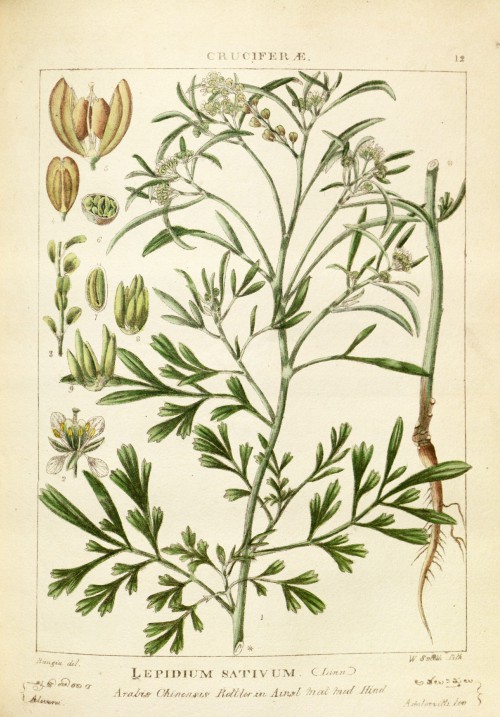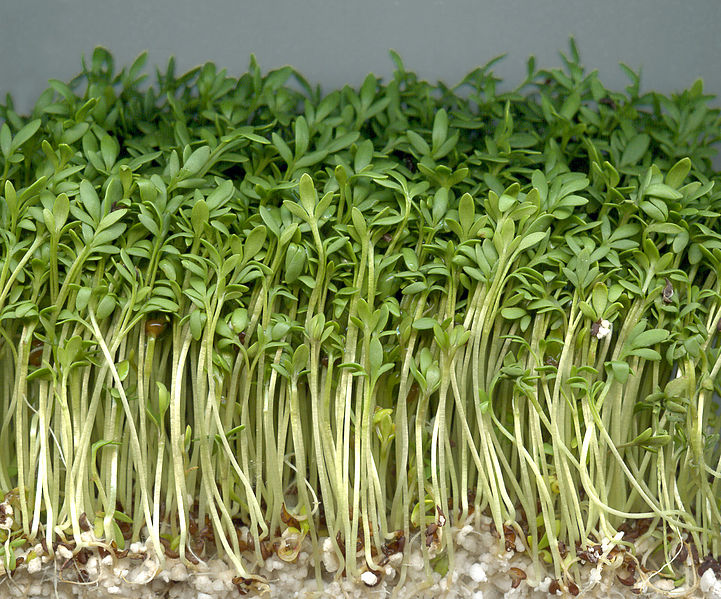Lepidium sativum L. - syn. Nasturtium sativum Medik., Thlaspi sativum Crantz. - Brassicaceae - garden cress, pepperwort, pepper grass, Gartenkresse
Annual herb, up to 60cm tall, native to western Asia and Northeast Africa, naturalized elsewhere, widely cultivated for sprouts; lower leaves pinnatisect or lyrate-pinnate, upper leaves linear, sessile; flowers small, 2-3mm, white to pinkish; seeds 3mm long, 1mm broad, brown.
Lepidium sativum L. ssp.spinescens (DC.) Thell. = wild form (Egypt to Iran)
Lepidium sativum L. ssp.sativum L. = cultivar (Lepidium hortense Forssk.; Nasturtium sativum (L.) Medik.)
[Hagers Handbuch der Pharmazeutischen Praxis, Springer 2010]
„Garden cress is added to soups, sandwiches and salads for its tangy flavor. It is also eaten as sprouts, and the fresh or dried seed pods can be used as a peppery seasoning (haloon). In England, cut cress shoots are commonly used in sandwiches with boiled eggs, mayonnaise and salt.“ https://en.wikipedia.org/wiki/Garden_cress
Volatile flavour components of garden cress found with GC-MS after simultaneous distillation and solvent extraction (SDE, 2-methylbutane) were benzyl cyanide (51.3%), 4-pentenenitrile (7.2%), 5-hexenenitrile (10.1%), 3-butenyl isothiocyanate (4.9%), 4-pentenyl isothiocyanate (8.0%), benzyl isothiocyanate (4.8%), 3-phenylpropionitrile (6.1%) and 2-phenethyl isothiocyanate (3.0%). „The most significant aspect of the list of identified aroma components of Lepidium is that all are glucosinolate degradation products and furthermore only four individual precursors are involved… The flavour of fresh garden cress is thus basically due simply to the blend of these isothiocyanates since the nitriles, although present in greater relative proportions, in comparison would not contribute greatly to the overall flavour. It is the isothiocyanates which provide the characterisic “bite” to the flavour.“
[Volatile flavour components of garden cress., Macleod, A.J., Islam, R., Journal of the Science of Food and Agriculture, 27(10), 1976, 909-912.]
Cress seedlings contained high levels (1.2mg/g fresh weight) of benzylglucosinolate (glucotropaeolin) and trace amounts of 2-phenethylglucosinolate in the first week following germination.
„Benzylglucosinolate degradation products were analysed in extracts of the seedlings of Lepidium sativum (‘curled cress’ and ‘plain cress’). Benzyl thiocyanate was positively identified in extracts of both types of cress, but it could not be detected after the onset of development of the true leaves. The relative percentages of benzylglucosinolate degradation products varied appreciably with age of the seedlings and with the length of time the shredded plant material was allowed to autolyse.“
[Benzylglucosinolate degradation in Lepidium sativum: effects of plant age and time of autolysis., Gil, V., MacLeod, A.J., Phytochemistry, 19(7), 1980, 1365-1368]

Wight,R., Illustrations of Indian botany, or figures illustrative of each of the natural orders of Indian plants, vol.1 t.12 (1840)
http://plantgenera.org/species.php?id_species=595366

commercial garden cress sprouts,
CC BY-SA 3.0, Author: Rainer Zenz Wikimedia Commons